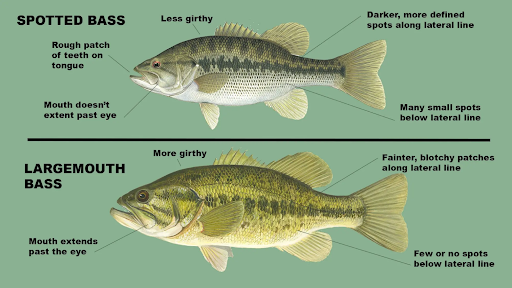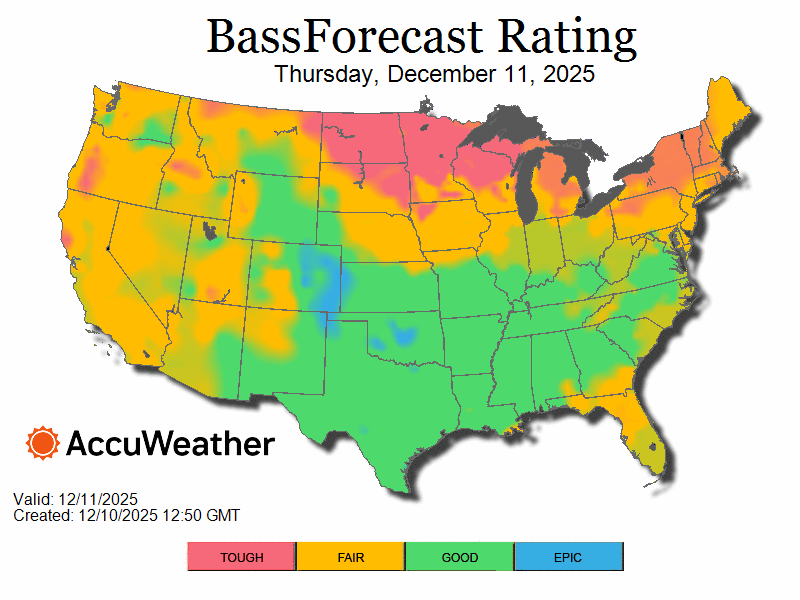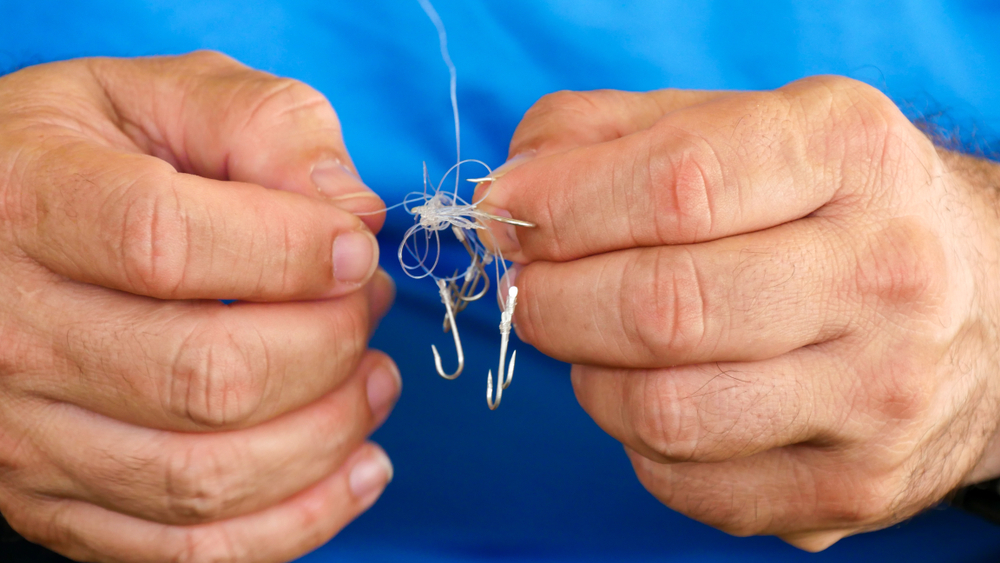Spotted Bass VS Largemouth Bass: All You Need to Know
Share this with every angler you know!
Largemouth bass are the primary target of most American bass anglers due to how common they are in nearly every state and the impressive fight they put up when you hook into them. However, they’re not the only bass species common in the US, and some other species look remarkably similar to a largemouth bass.
While seasoned anglers can likely tell the difference between largemouth and other species before they even get it out of the water, less experienced anglers often identify their bass inaccurately.
Today, we’re going to go over the differences between spotted bass vs. largemouth bass. Spotted bass tend to be fairly similar to smaller largemouth bass, and getting the two mixed up is a common issue with less experienced anglers.
Let’s get started.
Get notified of new bass fishing articles, tips and tricks!
Newsletter Signup
Understanding the Physical Differences Between Spotted Bass and Largemouth Bass
These two bass species differ in various ways, but when it comes to identifying them accurately, it’s all about their physical traits.
1: The Mouth
The mouth is the clear giveaway for whether you have a largemouth or not. The largemouth bass is the only North American bass that has a jaw hinge positioned behind the eye. This is how they get their name. The elongated mandible allows a largemouth to open its mouth far wider than any other bass and most other fish of the same size.
A spotted bass, and other bass species for that matter, have a shorter jaw that hinges in front of the eye.
That’s all you need to know to tell if you have a largemouth immediately, but the issues start to come in if it’s not a largemouth and you still want to identify your bass properly. Especially since younger bass don’t always have the most developed markings, and if the jaw is shorter, it can be difficult to tell different non-largemouth apart.
2: The Lateral Line
This is the second-best way to tell what type of bass you have as long as you’re dealing with mature bass. The lateral line is a marking that runs horizontally through the middle of the fish’s pattern.
Largemouth bass do not have a lateral line that you can easily see or use for identification. That’s okay because their jaw makes them incredibly easy to identify.
However, spotted bass get their name from this lateral line. On a mature spotted bass, the lateral line will be dark and spotted. This is an easy way to tell the difference between spotted bass and other non-largemouth species without looking at more obscure features.
Again, there can be an issue with younger fish fresh off the spawn. Their coloring doesn’t develop as much. In the winter, when they often lose some of their coloring they can also be harder to identify this way.
This can be a great feature to look for before you have the bass out of the water, too. If it opens its mouth and looks like a bucket, and it’s just a greenish fish, it’s likely a largemouth. If you see a distinguished spotted line, you probably caught a spotted bass.
You’ll get good at spotting these differences without having to spend time carefully analyzing the bass once you get them to your boat or the bank.
3: Lower Spot Pattern
From this point on, you don’t typically need to use these traits. If you do, you’re likely comparing a spotted bass to a species other than largemouth bass, because the first couple of traits are so consistent that you should know what you’re looking at right away.
However, there are still times you’ll need to dig a little deeper.
Both spotted bass and largemouth bass can have spots below their lateral line along the belly region. The difference is that largemouths can simply have a light-green or white belly or spots that are hard to see. A spotted bass will always have dark spots below its spotted lateral line.
You don’t necessarily need to look at this trait in most circumstances, but it can be useful if you’re not looking at a largemouth. Smallies and striped bass can require you to look at the belly to distinguish between them and spotted bass.
4: Cheek Scales
Again, this is a rarely used trait for identification purposes. The scales on the cheeks of spotted bass tend to be much smaller than those on largemouth bass.
5: The Tongue
Finally, you can check the tongue. Largemouth bass have a smooth tongue, and the only rough spots in their mouths are their tiny, sandpaper-like, teeth.
With a spotted bass, there’s a small rough patch on the tongue.
While this isn’t necessary to check when comparing largemouth bass and spotted bass due to more noticeable and reliable traits, it is crucial when comparing a spotted bass to a smallmouth bass.
Smallmouth bass have darker colorings, and they often have mark patterns that less experienced anglers can mix up. However, smallmouths have smooth mouths. If you’re ever confused, check the “tongue” for a rough patch.
Spotted Bass VS Largemouth Bass: Behavioral Traits
The following tips aren’t technically necessary to identify your bass properly, but they can help you get a better understanding of what to expect and how to strategize for each one. Some of them are also important for identifying the fish before you get them ashore.
Here are the key behavioral traits that you can use to differentiate between spotted bass and largemouth bass.
1: Water Breaches
This is one thing that all largemouth bass anglers with just a little experience know very well. Largemouth bass are famous for breaching the water, flaring their gills, and shaking violently when you hook them. It’s part of what makes their fighting skills so fun to counter because they’re unpredictably aggressive, and it’s truly a sight to behold.
However, spotted bass don’t tend to breach the water that often, and when they do, it’s not as spectacular of a show. They might jump every once in a while, but if you want that hyper-aggressive display, you have to target largemouth bass.
With spotted bass, you can expect them to start diving once they’re hooked. It’s similar to when you hook a catfish, and they run for their mudholes and other forms of cover on the bottom, but spotted bass don’t lock themselves in place for a tug-of-war match as often. Nor do they tend to have the sheer strength to do so.
2: Schooling
You will rarely find largemouth bass in schools. Even if you’re catching them back-to-back, likely, they’re just hunting close to one another. Largemouth are very solitary fish that love to stay on their own in most situations.
In contrast, spotted bass often school together. They’ll do this for hunting, traveling, and other activities. So, if you spot a school of bass on your sonar unit, you’re more likely to be looking at spotted bass than you are largemouth.
You’re also more likely to catch a multitude of spotted bass in the same spot than you are largemouth because of this behavioral trait. It’s easier to trick lots of them back-to-back in the same area when they’re all close together.
With bass, you usually pull one out of one tight spot, another a few yards away, and so forth if you’re making back-to-back catches.
Non-Identifying Traits of Spotted Bass VS Largemouth Bass
Finally, there are a few traits that you should know as an angler that don’t have much to do with identifying the two fish, but they’re still good to know.
1: Spotted Bass Don’t Live as Long
Spotted bass simply don’t live as long as largemouth bass do. Now, that might not seem like an important detail for someone who’s just catching them for sport, but it has a huge impact on their size.
While largemouth live up to 16 years in average conditions and longer in the best conditions, the average spotted bass only lives 6 years.
As a result, even the largest spotted bass pales in comparison to the sheer size of a largemouth bass.
The world record for spotted bass is 11.4 ounces. Many largemouth anglers can catch a 10-lb bass. While that’s still a large fish, it’s less than half the world record for largemouth, and it’s just shy of even the least impressive state-level largemouth records.
In general, the spotted bass you catch is going to be much smaller than a lunker largemouth.
2: Location
In terms of their native locations, spotted bass and largemouth bass are nearly identical. Naturally, they are found on the east coast and the center of the country in large numbers, and they often share the same waterways.
However, both of them have been introduced to almost all 50 states.
While you can catch both bass in most states, largemouth are still far more prevalent. They’re brought into more non-native waterways, and they’re so popular that they’ve even been introduced to Japan for sports fishermen to target.
So, largemouth are going to be a little more common in most states while spotted bass might require you to travel a reasonable distance to target them.
How many “Bass Fishing Season’s” are there in the US?
Choose your answer
a. 4 bass fishing seasons
b. 7 bass fishing seasons
c. 9 bass fishing seasons
d. 11 bass fishing seasons
3: Favorite Stomping Grounds
While spotted bass and largemouth bass often share waterways, spotted bass do enjoy different lake and river features.
While a largemouth can usually be found either along drop-offs or structure, spotted bass tend to stick around shallow streams and inlets that have relatively calm water and rocky bottoms, or they sit right out in the open in 30-foot depths.
Because of this, you usually have to switch up your approach to specifically target either species, but you can accidentally catch one while targeting the other if they happen to overlap while you’re fishing.
4: Seasonal Changes
If you like to fish in the winter, you’ll love spotted bass fishing. Largemouth bass can be caught in the winter, but it’s usually a lot more challenging. This is why some bass fishing tournaments, like Bass Master, are held in the middle of winter. It ensures that any angler winning it stands out above the rest and proves their merit.
However, spotted bass stay extremely active in the winter. Instead of contending with the weather and your limitations while also struggling with the fish, your ability to stay out and fish is the only thing affecting your catch rate. Spotted bass do just fine in the cold.
5: Lure Preferences
Bass are notorious for biting just about anything. They’re incredibly aggressive fish. However, they still have their preferences, and knowing them helps increase your catch rate and the quality of your catches.
The types of lures both fish like are largely the same, but it’s the size that matters.
Spotted bass are smaller fish with smaller mouths, and they usually want smaller baits. In comparison, largemouth bass can swallow just about anything in your tackle box without worrying about how big it is.
This doesn’t mean that a smaller bass lure will automatically ensure that you only catch spotted bass, though. Largemouth will frequently snatch up smaller lures, and one of the downsides of using smaller lures is that you also have to deal with smaller fish you’re not targeting. Everyone has brought in bull bluegill trying to toss a small curly-tail grub before.
Newsletter Signup
Spotted Bass VS Largemouth Bass: Which One Should You Target?
Now that we’ve compared spotted bass vs largemouth bass, which one do we recommend targeting the most as a CPR angler?
Well, there’s a reason largemouth are the number-one game fish in America, and it shouldn’t come as a surprise that we prefer them. That said, catching any type of fish is better than a day at work, and spotted bass provide a lot of fun.
In the winter, spotted bass can even be optimal. Most anglers hang up their rods for the year after the first frost due to the low catch rate of largemouth bass. Instead, try switching your target to spotted bass for year-round fun.
Regardless of which one you decide to target, Bass Forecast has plenty of resources to help you locate them, plan your trip, and target them effectively.
Download the Bass Forecast fishing app today!










.jpg)

.png)
.png)